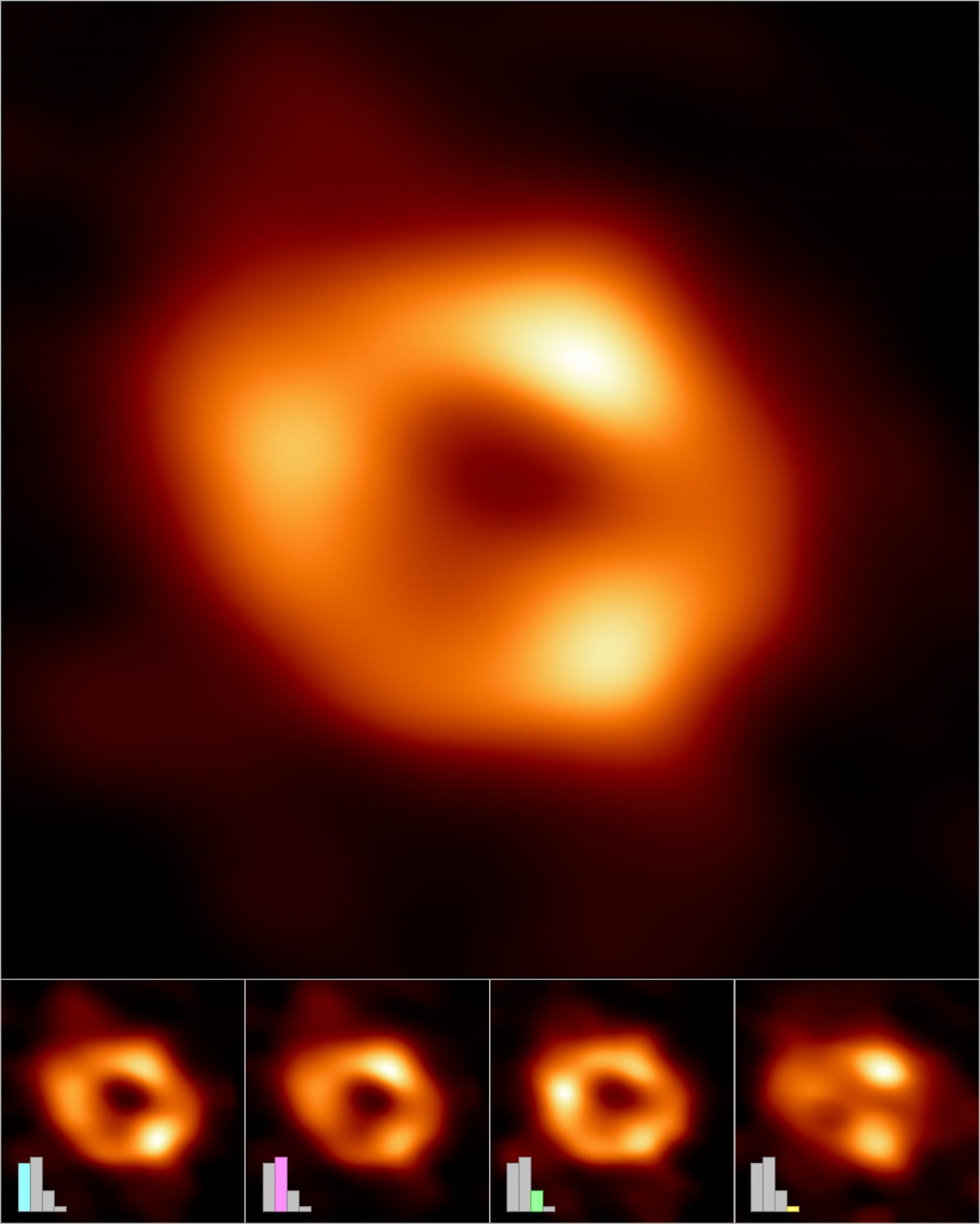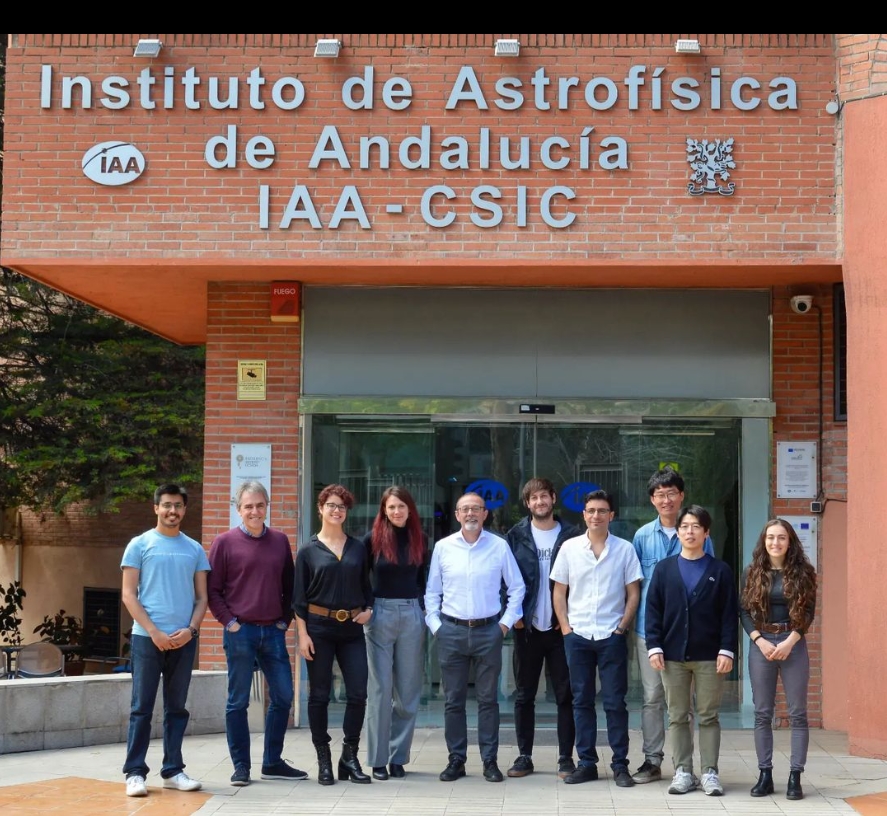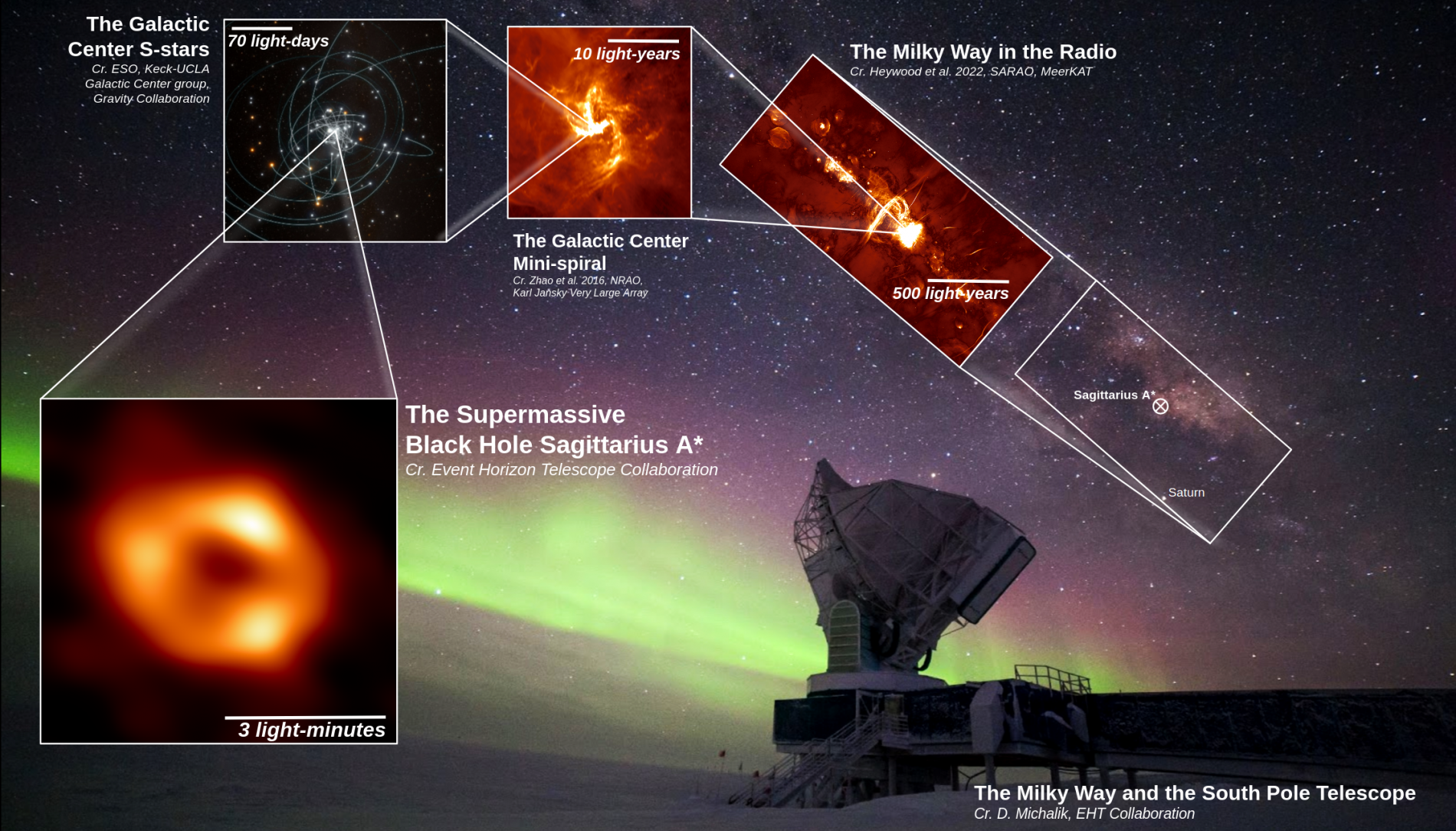Astronomers reveal first image of the black hole at the heart of our galaxy
This object, called Sagittarius A*, four million times more massive than the Sun, has been captured by the Event Horizon Telescope (EHT) international project. The finding, which has the outstanding participation of the Institute of Astrophysics of Andalusia (IAA-CSIC), confirms the existence of the black hole and helps to understand these gravitational 'monsters' from which nothing can escape, not even light. The image shows the dark central region surrounded by a bright ring-shaped structure, where light is bent by the black hole's powerful gravity
The image is a long-anticipated look at the massive object that sits at the very centre of our galaxy. Scientists had previously seen stars orbiting around something invisible, compact, and very massive at the centre of the Milky Way. This strongly suggested that this object — known as Sagittarius A* (Sgr A*, pronounced "sadge-ay-star") — is a black hole, and today’s image provides the first direct visual evidence of it.

Although we cannot see the black hole itself, because it is completely dark, glowing gas around it reveals a telltale signature: a dark central region (called a “shadow”) surrounded by a bright ring-like structure. The new view captures light bent by the powerful gravity of the black hole, which is four million times more massive than our Sun.
“We were stunned by how well the size of the ring agreed with predictions from Einstein’s Theory of General Relativity," said EHT Project Scientist Geoffrey Bower from the Institute of Astronomy and Astrophysics, Academia Sinica, Taipei. "These unprecedented observations have greatly improved our understanding of what happens at the very centre of our galaxy, and offer new insights on how these giant black holes interact with their surroundings.” The EHT team's results are being published today in a special issue of The Astrophysical Journal Letters.
Because the black hole is about 27,000 light-years away from Earth, it appears to us to have about the same size in the sky as a donut on the Moon. To image it, the team created the powerful EHT, which linked together eight existing radio observatories across the planet to form a single “Earth-sized” virtual telescope [1]. The EHT observed Sgr A* on multiple nights, collecting data for many hours in a row, similar to using a long exposure time on a camera.
The breakthrough follows the EHT collaboration’s 2019 release of the first image of a black hole, called M87*, at the centre of the more distant Messier 87 galaxy.
“Previous studies, awarded the Nobel Prize in Physics in 2020, had shown that an extremely compact object with a mass four million times greater than our Sun resides at the center of our galaxy. Now, thanks to the EHT, we have been able to obtain the first visual confirmation that this object is, almost certainly, a black hole with properties that perfectly match Einstein's Theory of General Relativity", says José Luis Gómez, member of the EHT Scientific Council and leader of the EHT group at the Institute of Astrophysics of Andalusia (IAA-CSIC). Research with the EHT is a fundamental part of the strategic project "Severo Ochoa" of the IAA-CSIC.
"The two black holes look remarkably similar, despite the fact that the black hole in our galaxy is more than a thousand times smaller and less massive than M87* [2]", highlights Antonio Fuentes, an IAA-CSIC researcher who participates in the find. "The fact that the event horizon-scale images of Sagittarius A* and M87* look similar, despite being two completely different types of galaxies and two very different black hole masses, is an extraordinary finding that confirms a key aspect of the theory of General Relativity”, adds Rocco Lico, IAA-CSIC researcher and co-author of the work.

This result was considerably more difficult than that of M87*, even though Sgr A* is much closer. Gas in the vicinity of black holes moves at the same speed -almost as fast as light- around Sgr A* and around M87*. But while the gas takes days to weeks to orbit the larger M87*, the much smaller Sgr A* completes an orbit in a matter of minutes. Thus, the brightness and pattern of the gas around Sgr A* changed rapidly as the EHT Collaboration observed it. On the other hand, the plasma, gas and dust located in the direction of SgrA* scatter the light, which adds an additional difficulty to the analysis of the data. "The most exciting result of this analysis is how it allows us to learn much more about our own galaxy, providing not only the first image of its central black hole, but also information about the turbulent interstellar medium in the galactic disk", says Guang- Yao Zhao, IAA-CSIC scientist participating in the study.
The researchers had to develop sophisticated new tools that accounted for the gas movement around Sgr A*. While M87* was an easier, steadier target, with nearly all images looking the same, that was not the case for Sgr A*. The image of the Sgr A* black hole is an average of the different images the team extracted, finally revealing the giant lurking at the centre of our galaxy for the first time.
The effort was made possible through the ingenuity of more than 300 researchers from 80 institutes around the world that together make up the EHT Collaboration. In addition to developing complex tools to overcome the challenges of imaging Sgr A*, the team worked rigorously for five years, using supercomputers to combine and analyse their data, all while compiling an unprecedented library of simulated black holes to compare with the observations.

"This result exceeds our expectations, and the collaboration is very excited: we now have images of two black holes of very different sizes, which offers a unique opportunity to compare them and study in depth how they work", says Thalia Traianou, an IAA-CSIC researcher involved in the result. "Another tremendously significant aspect of the results is the fact that they overcome the fundamental limitations of the VLBI imaging process by assuming an invariant structure during observation", adds Ilje Cho (IAA-CSIC), also a co-author of the study. They have also begun to use the new data to test theories and models of how gas behaves around supermassive black holes, a process that is not yet fully understood but is believed to play a key role in the formation and evolution of galaxies.
Progress on the EHT continues: a major observation campaign in March 2022 included more telescopes than ever before. The ongoing expansion of the EHT network and significant technological upgrades will allow scientists to share even more impressive images as well as movies of black holes in the near future.
Spain has made an essential contribution to the results presented today by the EHT. The Institute of Astrophysics of Andalusia (IAA-CSIC) has co-led at international level the work necessary to obtain the first image of the black hole in SgrA*. The IAA team involved in the discovery is made up of the researchers José Luis Gómez, Antonio Fuentes, Rocco Lico, Guang-Yao Zhao, Ilje Cho, Thalia Traianou, and Antxon Alberdi. Alberdi, director of the IAA-CSIC, stresses "the importance of these results within the Strategic Plan of the "Severo Ochoa" project of the IAA which, in turn, is providing funds for the recruitment of research staff of excellence for this project".

The University of Valencia, which has carried out a very important part of the analysis of the EHT data, and the thirty-metre IRAM antenna located in Sierra Nevada (Granada), which has played an essential role in the observations, have also participated in the results.

Notes
[1] The individual telescopes involved in the EHT in April 2017, when the observations were conducted, were: the Atacama Large Millimeter/submillimeter Array (ALMA), the Atacama Pathfinder Experiment (APEX), the IRAM 30-meter Telescope, the James Clerk Maxwell Telescope (JCMT), the Large Millimeter Telescope Alfonso Serrano (LMT), the Submillimeter Array (SMA), the UArizona Submillimeter Telescope (SMT), the South Pole Telescope (SPT). Since then, the EHT has added the Greenland Telescope (GLT), the NOrthern Extended Millimeter Array (NOEMA) and the UArizona 12-meter Telescope on Kitt Peak to its network.
ALMA is a partnership of the European Southern Observatory (ESO; Europe, representing its member states), the U.S. National Science Foundation (NSF), and the National Institutes of Natural Sciences (NINS) of Japan, together with the National Research Council (Canada), the Ministry of Science and Technology (MOST; Taiwan), Academia Sinica Institute of Astronomy and Astrophysics (ASIAA; Taiwan), and Korea Astronomy and Space Science Institute (KASI; Republic of Korea), in cooperation with the Republic of Chile. The Joint ALMA Observatory is operated by ESO, the Associated Universities, Inc./National Radio Astronomy Observatory (AUI/NRAO) and the National Astronomical Observatory of Japan (NAOJ). APEX, a collaboration between the Max Planck Institute for Radio Astronomy (Germany), the Onsala Space Observatory (Sweden) and ESO, is operated by ESO. The 30-meter Telescope is operated by IRAM (the IRAM Partner Organizations are MPG (Germany), CNRS (France) and IGN (Spain)). The JCMT is operated by the East Asian Observatory on behalf of the Center for Astronomical Mega-Science of the Chinese Academy of Sciences, NAOJ, ASIAA, KASI, the National Astronomical Research Institute of Thailand, and organizations in the United Kingdom and Canada. The LMT is operated by INAOE and UMass, the SMA is operated by Center for Astrophysics | Harvard & Smithsonian and ASIAA and the UArizona SMT is operated by the University of Arizona. The SPT is operated by the University of Chicago with specialized EHT instrumentation provided by the University of Arizona.
The Greenland Telescope (GLT) is operated by ASIAA and the Smithsonian Astrophysical Observatory (SAO). The GLT is part of the ALMA-Taiwan project, and is supported in part by the Academia Sinica (AS) and MOST. NOEMA is operated by IRAM and the UArizona 12-meter telescope at Kitt Peak is operated by the University of Arizona.
[2] Black holes are the only objects we know of where mass scales with size. A black hole a thousand times smaller than another is also a thousand times less massive.
More Information
The EHT consortium consists of 13 stakeholder institutes; the Academia Sinica Institute of Astronomy and Astrophysics, the University of Arizona, the Center for Astrophysics | Harvard & Smithsonian, the University of Chicago, the East Asian Observatory, Goethe-Universitaet Frankfurt, Institut de Radioastronomie Millimétrique, Large Millimeter Telescope, Max Planck Institute for Radio Astronomy, MIT Haystack Observatory, National Astronomical Observatory of Japan, Perimeter Institute for Theoretical Physics, and Radboud University.
Links
EHT website: https://eventhorizontelescope.org/
Instituto de Astrofísica de Andalucía (IAA-CSIC)
Unidad de Divulgación y Comunicación
Silbia López de Lacalle - sll[arroba]iaa.es - 958230676
https://www.iaa.csic.es
https://divulgacion.iaa.csic.es

